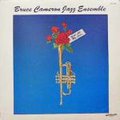Horn player Bruce Cameron's salad days in San Diego were during the 1970s and the 1980s. Then, Cameron got equal billing with heavy hitters like Shelly Mann, Cal Tjader, and Eddie Harris. His album Bruce Cameron Ensemble was a Billboard Recommended LP in 1980.
He teamed with future Fattburger star Hollis Gentry to form the Bruce Cameron-Hollis Gentry Ensemble, with whom he played trumpet and flugelhorn.
That band gigged at every club in Mission Valley, and at area hot spots now long gone: the Crossroads, the Blue Parrot, both of the Hubbell-designed Triton Restaurants, Elario's (at the top of the Summer House Inn in La Jolla,) the PB Café, the Del Mar Café, and Lehr's Greenhouse in Mission Valley.
"We got Humphreys going," Cameron says in his matter-of-fact style. "For the first year, we were the house band there. Those were the good old days. They hadn't gotten greedy yet." I make reference to the current stingy white chairs, the pain chairs, as I call them, and he smiles.
"They still had picnic tables then, and a restaurant - I can't remember the name of the place - they brought in barbecue."
He recalls a beach venue now long-gone called Le Chalet. "I worked as a county social worker then," says Cameron, a New York native, "but I gigged a lot. I talked the owner, a funny, round guy with a long white beard into letting us have jazz there. He moved the pool table out and built us a stage. It grew to three of four nights a week."
There was Cameron on trumpet and flugelhorn, Crawford alumni Nathan East and Carl Evans on bass and piano respectively, and a local drummer named Gary Nieves. The band's vocalist was Charlotte Steel.
"This was technically the start of Fattburger." Meaning that many of the ideas that Carl Evans would take to the national touring jazz act he co-founded later were developed in that working combo.
Cameron says those were the good years for a jazz musician in San Diego. "I looked at some of my union contracts from back then," he says, "and I'm seeing the kind of good money that nobody gets today. And it went a lot farther then, too." He talks about club residencies.
"Every hotel in Mission Valley had five-night-a-week bands, and bands on the off nights."
He then invokes some of the starpower names from San Diego's jazz scene past, like Kirk Bates. "There were two things tourists did when they came to San Diego: the Zoo, and the CC Jones show."
For a time, Cameron owned it in terms of a jazz career. His self-effacing stage manners belied the power and richness of his horn playing. But more than that, his name had drawing power. He became as big a star here as did anyone else at the club level.
He also worked in the model train industry, settling eventually at Reed's in La Mesa which he became a co-owner of. Model trains were his day job.
Then, in 1994, the worst thing that could happen to any trumpet player took Cameron out of the game.
While on a bicycle ride, he went over the handlebars. He landed on his face. In the accident, almost his entire top row of teeth was knocked out. The resulting surgeries left an accumulation of scar tissue along the inside of his upper lip - a serious handicap for a brass player.
"I never got it all back the way it was."
But chops or not, the love just isn't there for jazz at the club or the lounge levels any longer. He agrees that the local scene has atrophied over the years to the place such that it rarely supports a performer. Now, local jazz musicians tour Japan, or they teach, or they hold down day jobs. Sometimes, all three. What happened?
"That's a good question. From the time of our popularity, the one big change had to be the change in drinking-and-driving laws. That put a damper on the whole bar scene."
68 years old in 2012, Cameron may have lost the altissimo range but he still holds sway on the floor with his urbane manner and a trumpet tone that flows like water over stones. He jams several nights a week at closed sessions with jazz talent of equal caliber, and on Sundays, he fronts the KSDS - sponsored jazz jam at the Spaghetteria in Little Italy.
 Facebook
Facebook X
X  Instagram
Instagram TikTok
TikTok Youtube
Youtube

